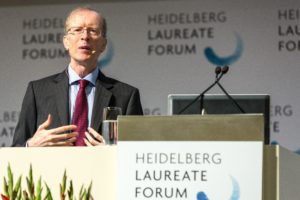The Langlands Program, Part II
BLOG: Heidelberg Laureate Forum


In a previous posting I explained a bit about the Langlands program, and the role of Fields medalist Ngô Bảo Châu in finishing the proof of a special case of the general functoriality conjecture. The other Langlands program talk here at the HLF was that of Sir Andrew Wiles, who back in 1994 (with help from Richard Taylor) proved a special case of the general reciprocity conjecture. By the next ICM Wiles was a bit too old for a Fields Medal, but was awarded a special prize by the IMU. He is this year’s Abel Prize laureate.
For those working on the Langlands program, the most important aspect of the Wiles result was the breakthrough in finding a way to prove an important case of the reciprocity conjecture, one whose history went back to the 1950s. This conjecture has been given different names, including various permutations of Shimura, Taniyama and Weil (leading to a certain amount of controversy over who deserved their name on the conjecture), but now is most often referred to as the “modularity theorem”.
For those not especially interested in the Langlands program, the significance of the result was the fact that it provided a proof of perhaps the most well-known open conjecture in mathematics: Fermat’s Last Theorem. This conjecture had been open for over 350 years, and attempts to prove it have provided much of the motivation of modern number theory. The 1994 proof was both a dramatic moment of solution of an old problem, but also a vindication of modern ideas about number theory in general, and the Langlands program in particular.
The way one gets Fermat’s last theorem from reciprocity is by contradiction. If one can find integers a,b,c satisfying an+ bn=cn for n>2, these can be used to write down the equation of an elliptic curve, which in turn gives a representation of the Galois group of the rational numbers. Langlands reciprocity associates to such things automorphic representations which can be characterized by modular forms. The contradiction arises because we know a lot about modular forms, in particular that the ones you should get this way can’t exist.
In his talk Wiles emphasized the idea that the Langlands program could be understood as a generalization from the Abelian to the non-Abelian case of deep ideas about the structure of number theory developed during the 19th century and the first half of the 20th century. The Abelian case is the subject known as “class field theory”. Parts of this theory were developed in the attempt to prove Fermat’s Last Theorem, but they always worked only for certain values of the exponent n, not all of them.
In the question session at the end, Atiyah commented that the transition to the non-Abelian case was something that also happened in other areas of mathematics and in physics (generalizing from the Abelian Maxwell equations to the non-Abelian Yang-Mills equations), indicating a vast unification of mathematics (and physics). Wiles is sympathetic to the conjecture that further unification is to come, but remarked that he was worried when Atiyah had first told him that ideas from physics would soon come to revolutionize number theory. He was reassured by theoretical physicist Cumrun Vafa, who told him it might go the other way, with ideas from number theory (e.g. the Langlands Program) revolutionizing theoretical physics.
Since his success with the FLT, many mathematicians have been wondering what Wiles will do next, whether he’s at work on another long-term project to solve one of the other great open problems of number theory. In response to questions, Wiles explained that he had told one or two people early on that he was working on FLT, but that he had quickly realized this led to endless questions from them about how it was going, and that it would be very distracting to have this generally known. He managed then to maintain secrecy until he was ready to unveil his results, and is not about to reveal any new such project.
The two great open problems one is tempted to speculate about are the Riemann hypothesis and the Birch Swinnerton-Dyer conjecture. Wiles did say that he wouldn’t try and work on the Riemann hypothesis if the only ideas available were analytical, outside his expertise. Next week in Oxford, he is giving a talk at a Clay workshop related to the BSD conjecture. It will just be a historical talk, not about new results, but still, maybe that’s a hint…

